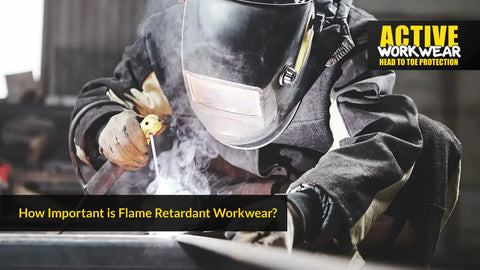How Important is Flame Retardant Workwear?
- by Mike Johnson

Working in a hazardous environment presents many challenges, from the obvious risks of injury and burns to lesser-known hazards such as toxic fumes, heat stress and arc flash. Thankfully several types of protective work clothing can help reduce the risk of harm. For example, workers in areas with flammable substances or potential for ignition must wear protective clothing that has been treated with flame-resistant properties.
Flame-resistant workwear is essential in industries where flammable liquids or vapours are present. Many believe fire-resistant clothing is only necessary for those working directly with open flames or high temperatures. However, this is not the case. Any worker who could be exposed to ignition sources (such as sparks from grinding, welding or even sparks from static electricity) should wear flame-resistant workwear as an additional precaution against burns and fires.
What is Flame Retardant Workwear?
Flame-resistant clothing is specially designed to resist the spread of flame or heat. As a result, it will only partially prevent the development of a fire. Still, it will slow down the spread of the fire and allow the wearer to exit the hazardous environment or prevent further damage.
The primary function of flame-resistant clothing is to prevent burns caused by direct flame contact or by contact with an ignition source such as an arc flash. Flame-resistant clothing uses specially designed fabrics that contain a chemical agent that will help slow the combustion rate of the material. Heat-resistant fabrics are also available, but these are designed for temperatures above the ignition point of the substance, so they are not as effective for flaming hazards. Heat-resistant fabrics are treated with a thermal finish and are common in welding clothing.
Why is Flame Retardant Work Clothing Important?
Flame-resistant workwear is essential for many industries, such as utilities, shipyards and manufacturing. However, the hazards of working with flames and high temperatures are not limited to these sectors.
One-third of all industrial fires happen during maintenance and repair activities, where no open flames may be present. In addition, sparks from grinding, sawing and welding can ignite flammable materials and create hazardous conditions for workers.
Arc flashes — a sudden burst of electrical current released during welding. Direct flame contact can also be a problem as exposure to fumes from flammable substances. Flame-resistant clothing is designed to resist the spread of flame and contact with high temperatures, so it is vital in reducing the risk of burns and fire in many industries.
How to Select the Right Flame-Resistant Clothing
The first step in selecting suitable flame-resistant clothing is to identify the hazards you may encounter at work. You can find information on the type of clothing required for each hazard on our website. The next step is to determine the level of protection you need. Workplace hazards are typically divided into usual, occasional and frequent.
Usual hazards rarely occur, such as proximity to a high-voltage electrical arc.
Occasional hazards, such as working with chemicals or grinding metals, are common but do not occur daily.
Frequent hazards occur daily and are expected to be part of the job, such as welding, hot work or working in a steel mill. At minimum, Flame-resistant clothing should comply with EN ISO 11612:2008 in the UK – Protective Clothing to Protect against Heat and Flame. Standard EN ISO 14116:2008 goes further to specify the requirements of limiting fire spread, so it burns itself out. Make sure to select the correct standard when shopping for protective clothing.
Other Protective Clothing Options
Although flame-resistant clothing is essential to any workplace safety strategy, it is not the only type of protective clothing available. Other types of workwear are designed to protect against specific hazards but do not meet the minimum requirements for flame resistance. Heat-resistant clothing is designed to protect against extreme temperatures above the ignition point of the fabric.
This type of workwear is most commonly found in welding apparel. It provides extra protection against sparks, hot metal and heat from the welding arc but does not offer any protection against direct flame contact. Chemical splash-resistant apparel is intended to protect against liquid spills and splashes but does not provide protection against high temperatures.
Conclusion
Flame-resistant workwear is an essential part of any safety strategy. It is designed to resist flame spread and protect against extreme temperatures. Flame-resistant clothing is essential to any workplace safety plan and particularly important for workers facing exposure to direct flame contact or extreme temperatures. Therefore, selecting the correct type of clothing for the hazards you face every day is essential as choosing garments that meet industry standards for flame resistance.
Here at Active WorkWear, we can help and advise you on Flame-resistant workwear and what's best for your working environment. So give us a call, email or message, and we'll be glad to help you.- Posted in:
- fire resistant clothing





